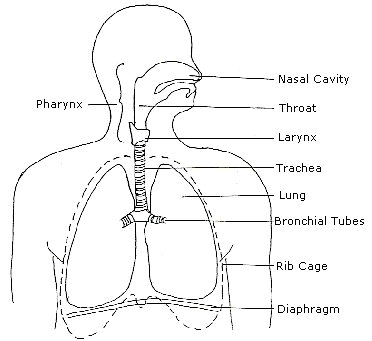

Anatomy & Physiology - Body Systems
The Respiratory System
The branches of science that will help you understand the body parts and functions are anatomy and physiology. Anatomy deals with studying the human body (the components, structure and position) and physiology is studying how the body functions.
Body Systems
The body comprises several systems: The cardiovascular system, Digestive system, Endocrine system, Muscular system, Neurological system, Respiratory system and Skeletal system.
The Respiratory System
The respiratory system comprises the nose, mouth, throat, larynx, trachea, bronchi and lungs. The respiratory system's function is to facilitate the gaseous exchange in the body's lungs and tissue cells.
Oxygen is required by cells in the body to allow various metabolic reactions to take place and produce energy which is essential to life.
The respiratory system may be defined as the organs and tissues passing air into and out of the body to allow the necessary gaseous exchanges.
External respiration is how oxygen from the air passes into the bloodstream for transportation to the tissue cells. Carbon dioxide is collected, transferred back to the lungs, and expelled from the body.
Internal respiration involves the vital chemical activities in every living cell requiring oxygen and glycogen to combine and release energy, water and carbon dioxide.
Organs of the respiratory system

The standard rate of inspiration and expiration, the respiration rate, is about 16 times a minute in an adult. Breathing is controlled by specialized brain centres, which automatically regulate the speed and depth of breathing depending on the level of carbon dioxide in the blood.
A-VO2 diff
Arterio-venous oxygen difference (A-VO2 diff) is the difference between oxygen concentration in the arteries and the veins' oxygen concentration.
Composition of Air
The composition of the air that we breathe in and out is approximate as follows:
| Breathed In | Gas | Breathed Out |
| 20.94% | Oxygen | 17% |
| 78.08% | Nitrogen | 78% |
| 0.04% | Carbon Dioxide | 4% |
| 0.94% | Tracer Gases | 1% |
Haemoglobin and Myoglobin
Haemoglobin is a protein in red blood cells which enables the cells to carry oxygen, and myoglobin is an oxygen-binding protein found in the heart and skeletal muscles.
Effect of exercise on the respiratory system
In the Cardiovascular system, the benefits of exercise were discussed concerning the improved functioning of the heart and the lowering of blood pressure. Combined with increased maximum oxygen consumption (VO2 max), or lung capacity, these are vital contributors to being fit and healthy.
Athletes who have not adequately trained their cardiovascular system are likely to incur other injuries more easily by the rapid onset of fatigue and the consequent lowering of motivation and mental awareness. Anyone competing at varying altitudes must allow themselves a considerable period to acclimate before an event. Even climbing to a moderate altitude decreases the maximum uptake by 7% to 8% due to atmospheric pressure changes. This decrease in oxygen supplied to the muscles may reduce performance by 4 to 8% depending on the competition's duration, a considerable disadvantage at the finish line.
Even the athlete who prepares and acclimatises well may not match natives of high-altitude areas such as the Andes. They have a larger chest capacity, more alveoli, larger capillary beds and higher red blood cell count. Since people may suffer from altitude sickness when moving from low to high altitudes, sufficient time must also be allowed for these symptoms to disappear before starting intensive training.
Page Reference
If you quote information from this page in your work, then the reference for this page is:
- MACKENZIE, B. (2001) Physiology - Respiratory System [WWW] Available from: https://www.brianmac.co.uk/physiolr.htm [Accessed